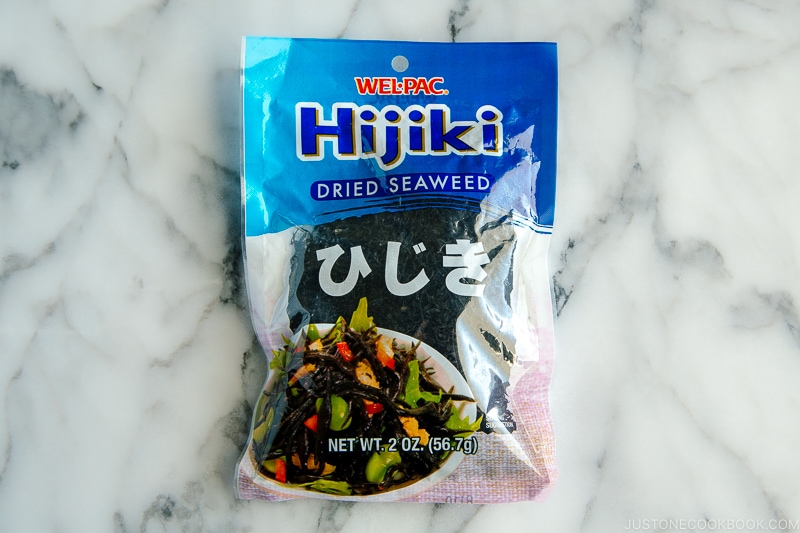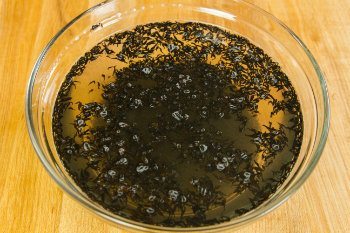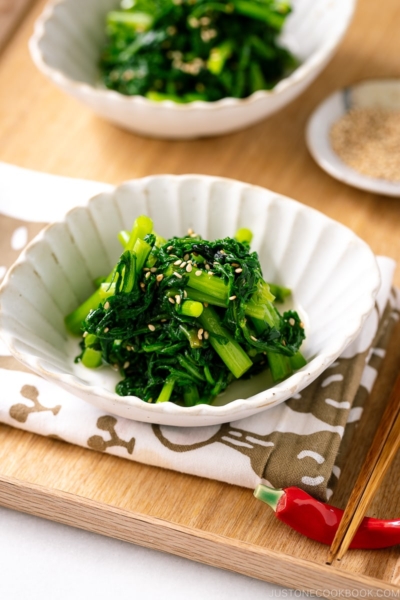A classic Japanese side dish, Hijiki Seaweed Salad features a type of wild sea vegetable that‘s packed with nutrients. Simmered with edamame and deep-fried tofu strips in a savory-sweet broth, this dish is full of flavor and perfect for meal prep. {Vegan Adaptable}

If you’re looking to include more sea vegetables into your diet, you’ll want to give hijiki a try. Resembling dried tea leaves but longer, hijiki is a type of wild sea vegetable that grows on rocky coastlines around Japan, Korea, and China. It has a sweet, clean taste and mushroom-like quality.
In Japan, we often enjoy it as hijiki no nimono (ひじきの煮物), which translates to “simmered hijiki.” It is technically a cooked dish, but you’ll find it called Hijiki Seaweed Salad at Japanese restaurants in the US.
Table of Contents
What is Hijiki Seaweed?

Hijiki seaweed is naturally green or brown in color when it’s hand-harvested by fishermen and divers in the wild. Before it’s packaged, hijiki is boiled and then dried, and this process turns hijiki black. You will need to rehydrate it by soaking it in the water prior to cooking.
Like other edible sea vegetables, hijiki is known for its dietary fiber and essential minerals like iron, calcium, and magnesium. After it’s cooked, it has a pleasant crunch and chewy bite. The taste is more earthy rather than oceany. The Japanese have been enjoying this traditional food as a part of a balanced diet for centuries.
Why You’ll Love This Recipe
- Great textures and flavors: It’s savory, sweet, and pleasantly crunchy
- Versatile: Serve this side dish in a Japanese dinner, lunch menu set, or bento box
- Meal-prep and freezer friendly: Make a big batch to enjoy throughout the week! It keeps in the fridge for 3–4 days or in the freezer for up to a month
- Packed with nutrients: Full of dietary fiber and minerals
Ingredients for Hijiki Seaweed Salad
You can leave out the optional ingredients, but hijiki salad always includes aburaage and edamame.
- dried hijiki seaweed – find it at Japanese supermarkets, Asian grocery stores, natural food stores, or online
- aburaage (fried tofu pouch) – adds protein and a lot of flavor
- carrot – adds color and nutrition
- edamame (young soybeans) – provides plant-based protein and a satisfying bite
- lotus root (renkon) – optional, but it adds a nice crunchy texture
- konnyaku (konjac) – optional; a jelly-like plant food unique to Japanese cuisine that’s very low in calories and high in fiber
- dashi – use homemade dashi, a dashi packet, or Vegan Dashi for vegan/vegetarian
- seasonings – soy sauce, mirin, and sugar
How to Make the Best Hijiki Seaweed Salad
There are various ways to prepare hijiki no nimono, but I really love my mom’s version. This is very close to how she cooks the dish.
- Soak the hijiki seaweed in plenty of water for 30 minutes. In the meantime, prep the other ingredients.
- Sauté the julienned carrots and sliced lotus root. Then, add the rehydrated hijiki, aburaage strips, and konnyaku strips.
- Add the broth and seasonings and simmer for about 30 minutes.
- Add the edamame and continue to simmer until the sauce cooks down and the ingredients soak up the simmering liquid.
- Cool to room temperature so the flavors mingle and settle in. Serve at room temperature.
Cooking Tips
- Season generously – When a dish is eaten at room temperature, you want to be generous with the seasonings so the flavors come through. Do not cut down on the sugar as we use it to balance the salt and enhance the overall taste.
- Don’t skip the fried tofu pouch – The sponge-like texture of the aburaage gives great depth, mouthfeel, and flavor to the dish, so don’t skip it.
- Make a big batch – Simmered hijiki is exactly the kind of dish that Japanese home cooks include in their meal prep. It keeps well and can easily enjoy throughout the week. You can mix it with white steamed rice to make Maze Gohan (Mixed Rice), add on top of soba noodles, or use it to make rice balls.

What to Serve with Hijiki Seaweed Salad
With contrasting textures and a concentrated sweet-savory flavor, Hijiki Seaweed Salad makes a truly unique Japanese dish that highlights the beauty of sea vegetables. I hope you enjoy it.
Try serving Hijiki Seaweed Salad with Grilled Mackerel, Japanese Spinach Salad with Sesame Dressing, White Steamed Rice, (Takikomi Gohan), and Miso Soup for a Japanese-style ichiju sansai meal.
Popular Similar Dishes
- Simmered Kabocha Squash
- Simmered Taro
- Simmered Koyadofu
- Simmered Bamboo Shoots
- Simmered Kiriboshi Daikon

Wish to learn more about Japanese cooking? Sign up for our free newsletter to receive cooking tips & recipe updates! And stay in touch with me on Facebook, Pinterest, YouTube, and Instagram.

Hijiki Seaweed Salad
Video
Ingredients
- ½ cup dried hijiki seaweed (1 oz; increases tenfold after rehydration; I used mehijiki (芽ひじき), the small, soft “buds“ of the hijiki plant; you can also use the long and chewy “stems” called nagahijiki (長ひじき), which are less commonly found in the US)
- 4 cups water (for soaking)
- 2 aburaage (deep-fried tofu pouch) (1.4 oz, 40 g; you can substitute crispy fried tofu cubes from an Asian grocery store, but blanch them first to remove the excess oil)
- 3 oz konnyaku (konjac) (⅓ konnyaku block; optional)
- 3 oz carrot (½–1 carrot)
- ¼ lotus root (renkon) (1.3 oz, 37 g; pre-boiled; optional)
- 1 Tbsp neutral oil
- 2 cups dashi (Japanese soup stock) (use standard Awase Dashi, dashi packet or powder, or Vegan Dashi)
- ⅓ cup shelled edamame (2 oz, 60 g; cooked; optional)
Instructions
- Gather all the ingredients.

- Soak ½ cup dried hijiki seaweed in 4 cups water—10 minutes for mehijiki (bud hijiki) or 30 minutes for nagahijiki (stem hijiki). Meanwhile, prepare the other ingredients.

- Drain to a large fine-mesh sieve and rinse under running water.

To Prepare the Other Ingredients
- Boil water in a small saucepan and pour it over 2 aburaage (deep-fried tofu pouch). This will remove the excess oil on the aburaage. Squeeze out the liquid. Then, cut in half lengthwise and thinly slice crosswise.

- Add some water and 3 oz konnyaku (konjac) to a small pot and boil for 3 minutes to remove the odor. This also helps the konnyaku absorb flavors and improves the texture. Then, slice it into small strips (about the same size as the aburaage slices).

- Cut 3 oz carrot into julienne pieces.

- Cut ¼ lotus root (renkon) into thin quarter pieces.

To Cook the Hijiki Salad
- Heat 1 Tbsp neutral oil in a medium pot over medium heat. Add the carrot and lotus root and cook until they are coated with oil.

- Add the hijiki, then the konnyaku and aburaage. Mix it all together.

- Add 2 cups dashi (Japanese soup stock) and let it boil.

- Add all the seasonings: ¼ cup mirin, 2 Tbsp sugar, and ¼ cup soy sauce. Mix well. Cook covered on medium-low heat for 20–30 minutes.

- Add ⅓ cup shelled edamame.

- Continue to cook, uncovered, to reduce the sauce until you see the bottom of the pan.

To Serve
- Serve as a side to a Japanese meal or pack in a bento lunch box. For convenient meal prep, you can divide the Hijiki Salad into a bento portion in silicone cups for freezing.

To Store
- Store in an airtight container and keep in the refrigerator for up to 3–4 days. You can also freeze it for up to a month.









Oh my goodness! Delica was my all-time favorite lunch spot when I worked in San Francisco. I still crave their food. The first time I tried hijiki was there and can’t wait to try this recipe!
Hi Diana! I hope you enjoy this recipe! I hope there are more shops like Delica. 🙂 Thank you for your feedback!
My sister was at first wary of this dish since it has so much seaweed, but changed her mind after the first bite. My family loves it. ☺️
Hi Kristi! Hahaha I’m glad your sister came around to enjoy it! Thank you so much for trying this recipe! xoxo
If you google, there is a discussion about it and hope that answers to your question. Unless you eat crazy amount everyday (which is impossible) it’s supposed to be okay. It’s just the law that has to put the label. Here’s pretty good article that summarizes what I believe:
https://www.edenfoods.com/articles/view.php?articles_id=79
Hi Nami! So I live in NYC and had hijiki seaweed several times from the local Japanese deli and really liked it. However, I’ve read articles about UK and US food authorities warning about the arsenic content in it that might lead to cancer. Just curious how you or people in Japan think of it as a concern or consider it’s safe to eat on a regular basis?
Hi Emily! If you google, there is a discussion about it and hope that answers to your question. Unless you eat crazy amount everyday (which is impossible) it’s supposed to be okay. It’s just the law that has to put the label. Here’s pretty good article that summarizes what I believe:
https://www.edenfoods.com/articles/view.php?articles_id=79
I love seasoned hijiki. I am glad to find your recipe.
Hi Anne! Hope you enjoy this recipe! 🙂
thank you for this recipe. we just got back from japan and i was dying to know how to recreate this!! we stayed at a ryokan and had it several times but due to the language barrier i could not know what it was until now!
Hi Grace! Aww I’m so glad you finally figured it out. 🙂 Hope you enjoy re-creating this recipe at home!
My mom made something similar, but she used (cooked) dried soybeans instead of the edamame. Can’t wait to try your recipe…it sounds easier than hers!
Hi Tina! Sure you can add the dried soybeans too. I always have to think about how the picture will turn out to showcase this dish on my blog, so try to add green… 🙂
Hi Nami:
Finally got around to cook from the hijiki brought back by a good friend. I loved the taste as it’s way better than some of the thicker seaweed I’ve tasted in Taiwanese cooking (they usually use the knotted kind). Those tend to be flavourless and just used as a filler for a dish. I also like the texture of hijiki as they were soft and not “ligament”/chewy/crunchy like. Don’t know if it’s the correct texture or have I overcooked it?
I made dashi using your recipe and then followed your hijiki recipe but since I didn’t have lotus or konnyaku or aburaage so I put a bit more carrots and edamame (didn’t do any exact calculation to compensate for the missing items). I found that my carrots lost its vibrant colour as I was cooking and later on after the 30 min mark, I put in the edamame, they lost the green colour as well. I still had a lot of water left so I continued and then up to a point, I decided that was long enough and stopped cooking. I still had some liquid left but was less than when I started after adding the edamame. What am I doing wrong? Have I overcooked them? How can I correct it for next time?
Hi Christina! By simmering carrot for a long time, it does lose the original bright color because of soy sauce. Edamame is cooked already (the one I used) so you only need to warm up. By the time you add edamame, liquid should be almost gone. How was the texture of the carrot? Was it mushy? You can control how long it cooks based on the doneness of your carrot. 🙂
Hi Nami: I cooked on medium-low heat for 30 min but still lots of water. Hmm unless I cooked on too low of a heat. So then I added cooked edamame to cook until there’s hardly much water. The texture of the carrots were soft but not mushy. I’ll have to get more hijiki in order to adjust my cooking. It’s a keeper as my mother has been cooking lotus roots with carrots and edamame using your recipe even if we have no more hijiki left. Thank you again for your post. 🙂
Keep me posted. Hope it’ll work next time. Thank you so much for your feedback. xo
Hi Nami!
You keep knocking them out of the park with your recipes. Every time I think you can’t top the current recipe I’ve tried, you prove me wrong. We have loved every one of them (and I’ve made a LOT so far!).
Should this hijiki salad be served hot/room temperature/cold or is it great at all temperatures? Looking forward to trying this one out as I’m trying to add more seaweed (nori, wakame, hijiki, konbu), edamame, and konyakku to our diets.
Thanks for all of the wonderful recipes. My 84-year-old mom will often say “Grandma used to make this.” so they bring back nice memories for her too.
Gayle
Hi Gayle! Thank you so much for your kind feedback. I’m happy to hear you enjoy my recipes! 🙂
Regarding the temp this dish should be served… my personal preference is cold. It’s sweet and savory dish that I enjoyed it chilled.
I tend to eat a bit too much when it’s cold. I also like it hot if I put some of it on the rice and eat together. Basically it works great for all temp (hijiki in bento is often served at room temp).
I’m so happy to hear your mom enjoys this dish. We do remember food we grew up eating and it brings so much joy and comfort especially as we get older (I’m talking about myself…. 🙂 ).
Thanks Nami. without you, I could have never finished my work 😉
Hi Nikki! Aww thank you!! Hope you enjoyed this recipe! xo
I love hijiki salad. I don’t know if I will be able to find the ingredients here in Colorado, but thank you so much for posting the recipe!
Hi Aquila! You can find it on Amazon too, in case you can’t find locally. 🙂
http://amzn.to/2gvpZPM
Hope you enjoy!
Nami=san:
I have a question about hijiki. I am looking for a hijiki that is more tubular in shape . I can find the hijiki that is very fine in dry form, and when hydrated, looks quite thin. I bought a type that is larger and more tube-like and was more tasty. I can not find it again, and was wondering if it has a different name.
Hi Carlyn! You don’t have a picture of what you cooked or used right? If you do, email me? I can’t think of anything at this time…
Was it Arame?
https://en.wikipedia.org/wiki/Arame
Hi,I really like your post,there is a question keep confusing me,I’ve had a dinner at a Japanese restuarnt before,I orderd a seaweed salad,but this type of seaweek is a little bit different from I’ve had before,it looks more green and crunchy than normal seaweek,I really like this,then I bought the seaweek in Japanese shop,but it is NOT waht I had in the restuarnt,I was so disappoited,so I’ve try to search in google to find out what type this seaweed is,but it seems no point,it is only called seaweed in google.I think I need you to help me find out what type of this seaweed is.At last here is a photo I got in google,because I can not attach a photo here,I hope you can understand clearly what I say.Thanks a lot!
http://mmbiz.qpic.cn/mmbiz/Iqz5hXhALiaYrw6MiaP6Yxuk7bxsiafpKCJpGlMQoe5JzXic7ndHbH1G5n0zODqAhBYGVsWxZ8dhGgSRF24eWA3mEg/0?wx_fmt=jpeg
Hi Yumi! Thank you for reading my blog! 🙂 I wrote about this seaweed salad in this post.
https://www.justonecookbook.com/seaweed-salad-recipe/
I love Hijiki salad but have only had it in Japanese restaurants in Singapore. Bought a bag recently, searched your blog & found your recipe. Made it last night knowing I will not be disappointed. Hubby looked at it suspiciously, took a small bite & his eyes lit up BIG time! After a few more dips, he declared, “oh my, this is addictive!” It’s a keeper! Thank you Nami, for sharing your wonderful recipes. I love your recipes because they are authentic yet easy to follow. Keep up the good work!
Hi LayChin! Aww I’m so glad your husband liked this dish too! Now you can make more often. 😉 It’s much more economical making this at home than ordering at a restaurant (and you can adjust the flavor as you wish). Thank you for your kind and sweet comment about my recipes. I’m just so happy that you are making this dish at home! And your husband reaction….. hahaha… I don’t share hijiki much on my social media because it is hard to convince people this IS a good dish with black seaweed. LOL.
I love hijiki, but I’d never put lotus root in it before. It was so good! Thank you!
Hi Ann! I love hijiki too! t’s good without it too. Thank you for trying this recipe and writing your kind feedback! 🙂